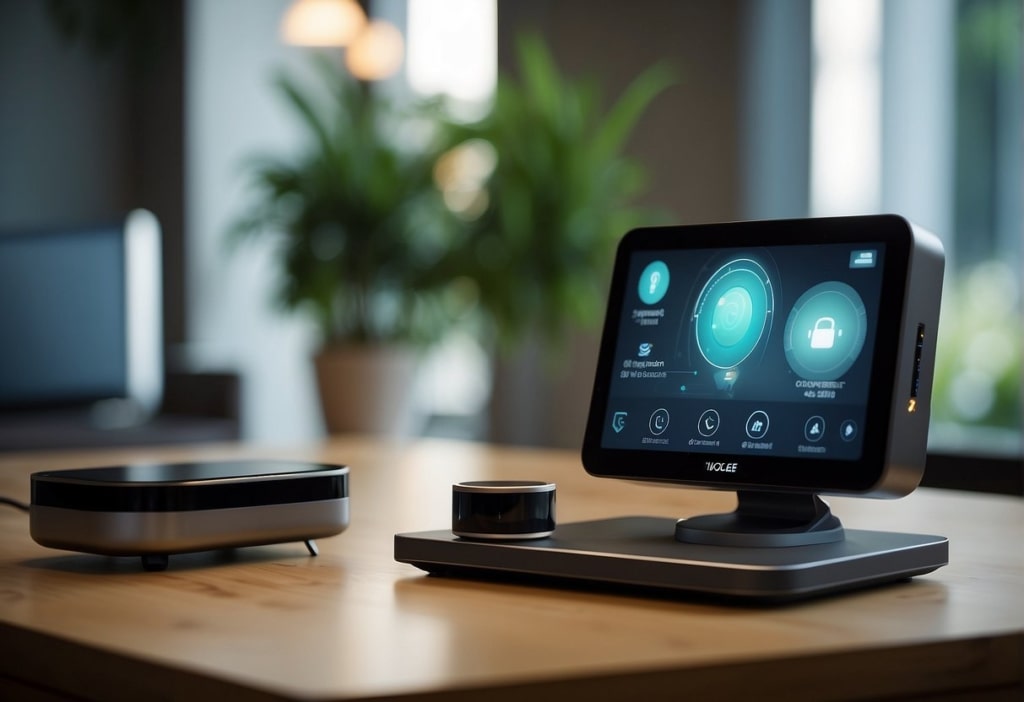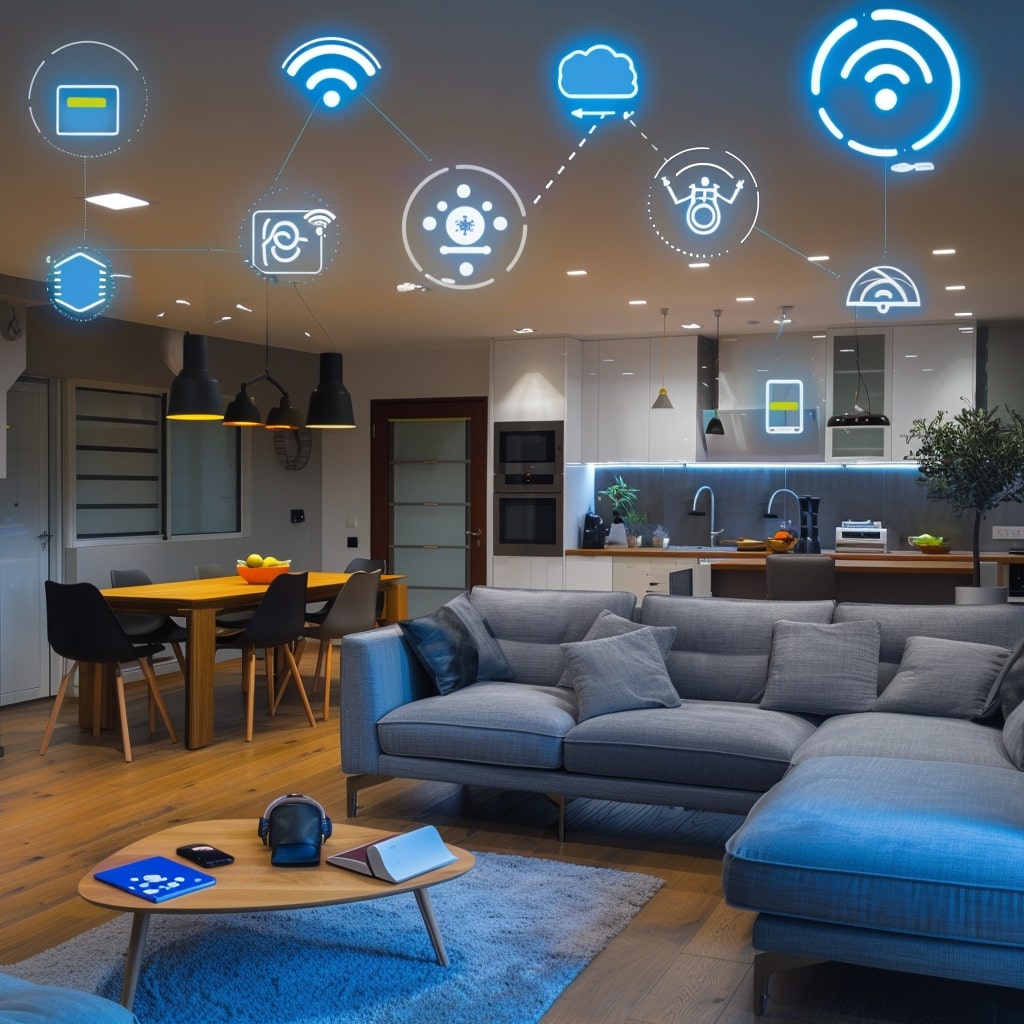Ambient computing represents the seamless integration of technology into our daily lives. It points to a future where technology operates invisibly in the background, allowing us to interact with various devices effortlessly through voice, gesture, and context-aware actions.
The philosophy behind ambient computing is to create a digital environment that is intuitive and unobtrusive, making technology feel like a natural extension of our living and working spaces, and an extension of ourselves.

Smart homes are one of the most tangible applications of ambient computing. They harness a combination of artificial intelligence (AI), ambient intelligence, and the Internet of Things (IoT) to create living spaces that respond to the needs of their occupants. By integrating sensors and smart devices, a smart home can learn the preferences of its inhabitants and automatically adjust systems such as heating, lighting, and security to deliver comfort, convenience, and peace of mind.
What is Ambient Computing?
- Ambient computing has the goal of creating effortless interaction with technology in day-to-day life.
- Smart homes leverage AI and IoT to create responsive, intuitive living environments which are seamlessly blended into daily living.
- Machine learning (AI) evolves and learns from human behaviour, thus anticipating functions of smart technology based on experience.
How does ambient computing enhance the functionality of smart homes?
Ambient computing elevates smart homes by providing an unobtrusive, intuitive user experience. It anticipates needs and automates tasks without requiring direct interaction, making smart home environments more responsive and adaptive.
Fundamentals of Ambient Computing

Ambient Computing represents a significant shift in how users interact with technology, seamlessly integrating computing capabilities into the environment.
Understanding Ambient Intelligence
Ambient Intelligence (AmI) is the backbone of Ambient Computing. It embodies systems that are sensitive, responsive, and adaptive to the presence of people. Ambient Intelligence environments are equipped with sensors and devices that can collect, process, and respond to data in a manner that is unobtrusive and often invisible to the user. These environments understand the context of user actions and preferences, allowing for a more intuitive interaction between humans and technology.
- Core Characteristics of Ambient Intelligence:
- Context-aware: Recognizes and interprets real-world conditions.
- Personalized: Tailors responses to individual user preferences.
- Adaptive: Changes behaviors according to the environment and user context.
- Anticipatory: Predicts user needs and acts proactively.
The Role of AI and Machine Learning
Artificial Intelligence (AI) and Machine Learning (ML) are pivotal in achieving the goals of Ambient Computing. They process the vast amounts of data collected by sensors and devices to make informed decisions. Through learning algorithms, ambient systems improve over time to better serve the user’s needs.
- Influence of AI and ML in Ambient Computing:
- AI enables systems to perform tasks that normally require human intelligence, such as decision-making and speech recognition.
- Machine Learning allows systems to learn from experience and improve functionality without explicit programming.
In summary, Ambient Computing leverages Ambient Intelligence with the power of AI and ML to create environments that are context-aware, personalized, and adaptive, providing a seamless and intuitive interface between humans and technology.
Infrastructure of Smart Homes

The deployment of smart home infrastructure comprises an intricate network of hardware and software that enables devices to communicate and function cooperatively. Understanding the critical components in this system is essential to grasp the sophistication and capabilities of current smart homes.
Hardware Essentials: Sensors and Actuators
The backbone of a smart home lies in its hardware components, principally sensors and actuators. Sensors detect environmental conditions or changes, such as motion, temperature, or light levels, and convey this data to the system. Prominent types of sensors include:
- Motion detectors
- Temperature sensors
- Light sensors
- Humidity sensors
- Cameras
Actuators are the counterpart to sensors, responsible for effecting change in the environment by controlling mechanisms. Examples include:
- Smart locks
- Thermostats
- Lighting systems
Software and Platform Integration
Smart homes leverage software platforms to integrate the data collected by sensors and issue commands to actuators. These platforms may include proprietary systems developed by companies or open-source solutions. Key aspects involve:
- User profiling: software adapts to user behaviors and preferences.
- Multimedia integration: combining audio, video, and control systems for a seamless user experience.
- The architecture of the system, ensuring reliable performance and scalability.
Connectivity and IoT Ecosystem
At the core of a smart home’s functionality is connectivity. It ensures seamless communication between devices, platforms, and the broader Internet of Things (IoT) ecosystem. Important connectivity protocols include:
- Wi-Fi
- Zigbee
- Z-Wave
- Bluetooth
- Matter
These protocols are pivotal in maintaining a robust IoT network that enables devices to interact with each other and with internet-based services, making the integration of the smart home into the daily lives of individuals increasingly effective and intuitive.
User Experience in Smart Homes

User experience in smart homes is deeply influenced by the seamless interaction with technology and personalized, adaptive features focused on accessibility for everyday use.
Voice Assistants and User Interaction
Voice assistants like Amazon’s Alexa and Apple’s Siri have transformed user interaction within smart homes. These digital assistants facilitate a hands-free experience that is fundamental to ubiquitous computing. Users can issue voice commands to control smart devices, whether it’s asking Alexa to play music or using Siri through an iOS device to set reminders. The reliance on cloud technology ensures that voice commands are readily processed, offering a responsive customer experience.
Personalization and Adaptive Technology
Smart homes have evolved to not just execute user commands, but also to anticipate needs through personalization. Adaptive technology utilizes data from user behavior to automate settings, like adjusting lighting or thermostat levels. This personal approach to technology means that a user’s smartphone and smart devices become more attuned to their habits over time, enhancing efficiency and convenience.
Accessibility and Daily Use
Accessibility is paramount in the design of smart homes, ensuring that technology serves a wide range of needs and abilities. Features like voice control and remote access via smartphones make daily tasks more manageable for individuals with varying levels of mobility. Moreover, security and privacy are integral, with users expecting robust measures to protect their personal information from unauthorized access, which manufacturers must continuously address to maintain trust and provide a secure environment.
Privacy and Security Considerations

Ambient computing in smart homes, with devices such as smart speakers and smartphones, has brought convenience and efficiency to daily life. Yet, it also raises critical issues of privacy and security.
Privacy
Smart home devices often collect vast amounts of data. Edge computing, which processes data at the periphery of the network, can mitigate privacy risks by limiting the amount of sensitive information transmitted to the cloud. Silicon Valley companies are increasingly integrating edge computing into their devices to enhance privacy.
- Smartphones: These ubiquitous devices can serve as a control hub for smart homes while posing significant privacy risks due to their data collection capabilities.
- Smart Speakers: Users should be aware that such devices continually listen for activation commands, which could lead to inadvertent recordings and privacy breaches.
Security
The integration of Internet of Things (IoT) devices into smart homes necessitates robust security measures to protect against unauthorized access and cyber-attacks.
- Data Protection: Implementing strong encryption and secure authentication protocols ensures data integrity and mitigates the risk of compromise.
| Concern | Security Measure |
| Data Theft | Encryption |
| Unauthorized Access | Two-factor Authentication |
| Network Attacks | Regular Firmware Updates |
Companies must prioritize both privacy and security in the design of their products and the education of their consumers. Users should be encouraged to employ complex passwords and regular software updates to safeguard their smart home ecosystems.
Frequently Asked Questions

Ambient computing is transforming smart homes by integrating advanced technologies seamlessly into daily life. This section addresses common queries to understand the practical implications and considerations of this evolution.
What are the primary cost considerations for implementing ambient computing in a home environment?
The costs for implementing ambient computing in a home involve initial hardware expenses, installation fees, and potential ongoing charges for cloud services or software updates. Consumers should evaluate the total investment against the benefits of enhanced automation and efficiency.
How do ambient intelligent systems differ from traditional smart home systems?
Ambient intelligent systems proactively adapt to user behavior and preferences, offering a more contextual and anticipatory approach to automation compared to traditional smart home systems that rely on direct user commands.
In what ways can ambient computing improve energy efficiency in smart homes?
Ambient computing augments energy efficiency by smartly managing resources, such as lighting and heating, based on occupancy and usage patterns, leading to reduced energy consumption and lower utility bills.
What are the privacy and security implications of ambient computing in residential settings?
The integration of ambient computing raises concerns regarding data privacy and security. It is crucial for devices to have robust encryption and for manufacturers to follow best practices to protect user data from unauthorized access.
How do ambient computing devices communicate and integrate with each other within a smart home ecosystem?
Ambient computing devices typically communicate through wireless protocols, including Wi-Fi, ZigBee, and Bluetooth. They integrate using common standards to ensure seamless operation and create a cohesive ecosystem within the smart home.



